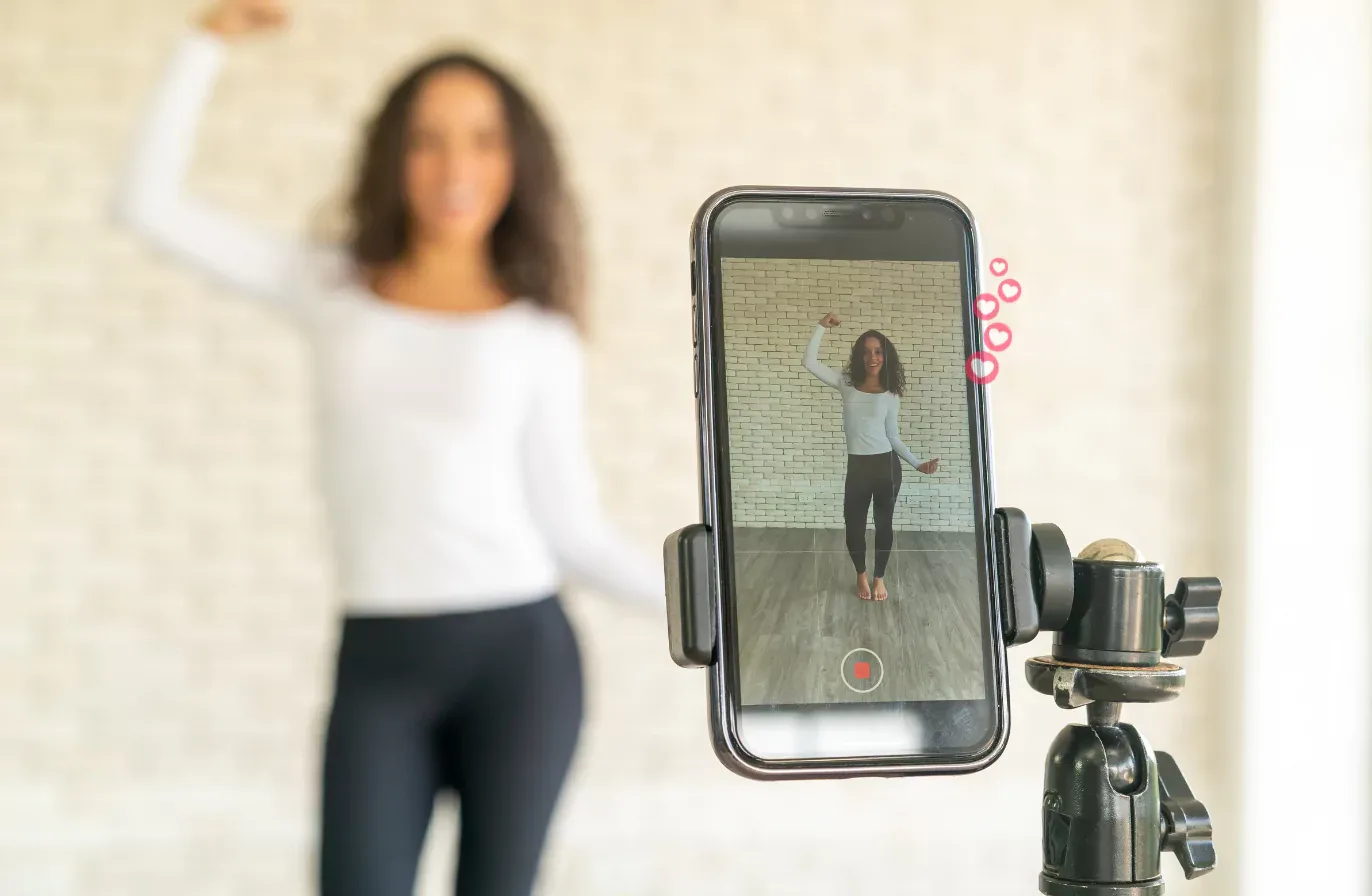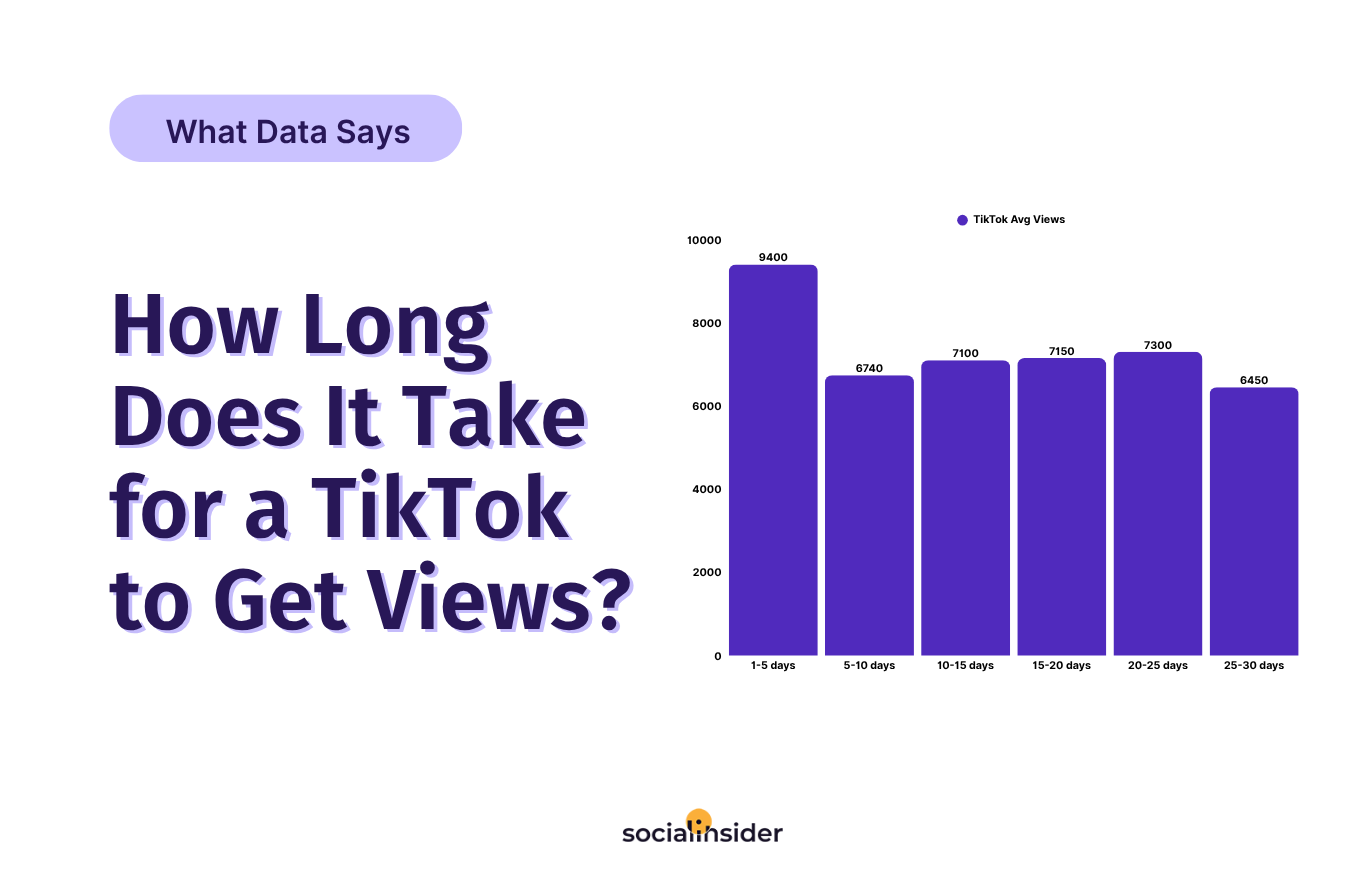TikTok vs. Reels vs. Shorts (A Study by Socialinsider)
Discover the key differences between TikTok vs Reels vs Shorts. Get insights on features, trends, and tips for maximizing your video reach.



Short-form video has completely transformed the way we connect, share, and discover content online. With TikTok, Instagram Reels, and YouTube Shorts all competing for attention, each platform brings its own unique strengths—and challenges—for brands and creators.
In this article, I’ll break down the latest engagement trends, audience insights, and performance data to help you navigate where your content and strategy will have the biggest impact.
Whether you’re focused on driving conversations, maximizing reach, or finding the right platform for your audience size, you’ll find actionable observations and honest reflections to guide your next move.
Executive summary
- TikTok’s engagement rate continues to climb, solidifying its lead, while Instagram Reels and YouTube Shorts see only modest or stable growth.
- TikTok generates the most conversation with an average of 54 comments per video, compared to 35 on Reels and just 20 on Shorts.
- YouTube Shorts often outperforms the others in average views for smaller and mid-sized accounts, but TikTok emerges as the top platform for view counts once creators build a larger following, while Instagram Reels remains consistent but less dominant.
What are Instagram Reels?
Instagram Reels are short videos lasting up to 180 seconds, with music or audio and featuring a range of creative tools. These tools include AR effects, a timer, and an alignment tool for transitions, which assist users in creating engaging and visually appealing content.
One of the advantages of Reels is its integration within the Instagram ecosystem. Reels can be discovered in the newsfeed, in Stories, and in the dedicated Explore tab, making them a natural part of users’ existing Instagram habits.
This means that Reels can significantly boost engagement for brands and creators by leveraging Instagram’s already extensive user base.
Understanding who is most likely to engage with Reels adds another layer of strategic value for brands.
Instagram’s user demographics reveal that the platform is particularly popular among younger audiences: 29.5% of users are aged 18–24, and 31.6% fall within the 25–34 range. Together, these groups make up more than 60% of the user base, while audiences aged 35 and older represent a progressively smaller share. This youthful audience not only drives trends but is also highly receptive to short-form, creative video content—making Reels an effective format for reaching and engaging the core of Instagram’s community.

By leveraging both the creative flexibility of Reels and the platform’s demographic strengths, brands and content creators can maximize their reach and engagement, connecting authentically with Instagram’s most active audiences.
What is TikTok?
TikTok is one of the leading platforms for short-form video content. Known for its highly engaging content, TikTok allows users to share 15-second to 10-minute videos on various topics.
Launched globally in 2018, TikTok stands out through its algorithm, which tailors the “For You” page to users’ preferences, making content discovery personalized and “addictive”, especially among Gen Z and Milennial users.
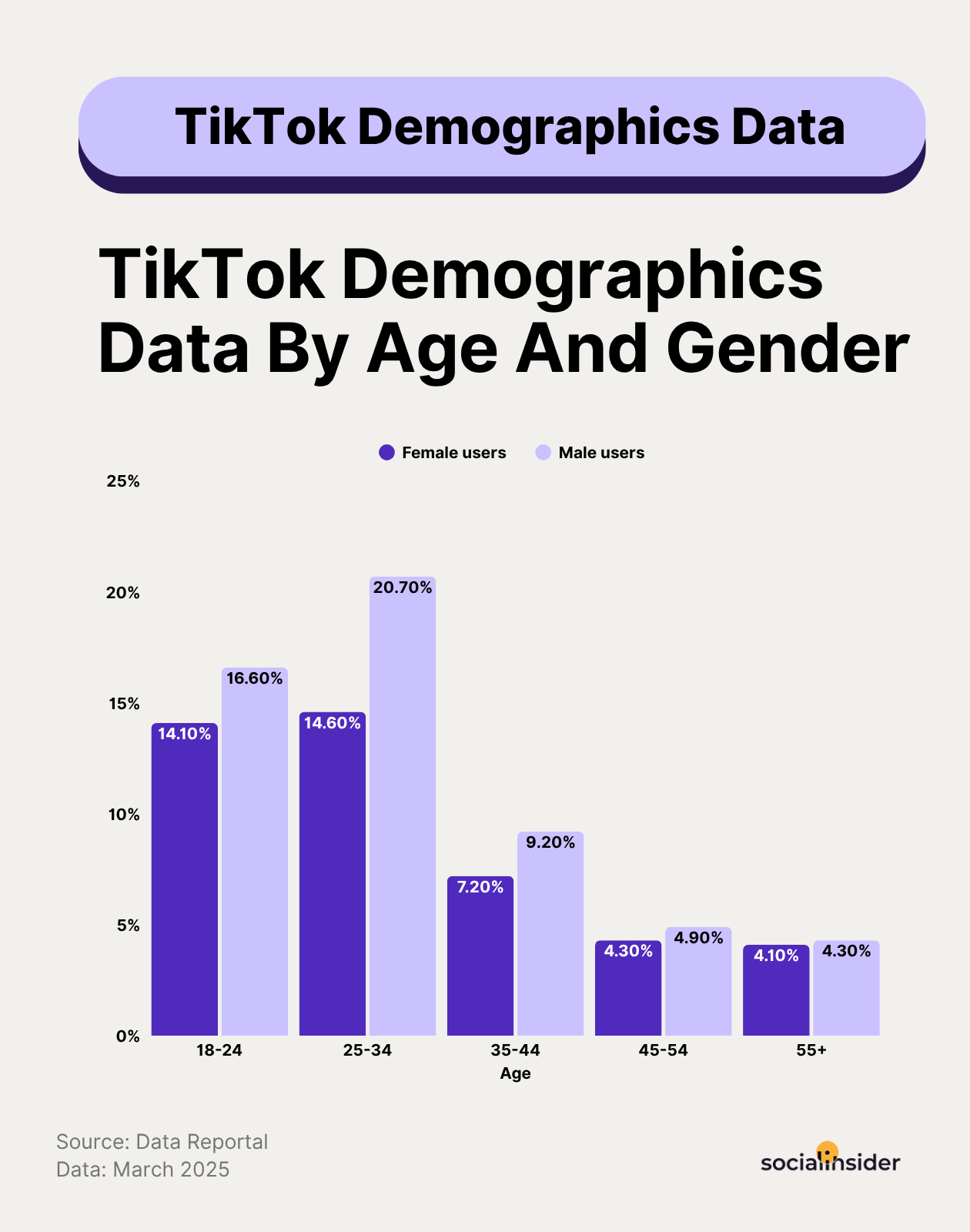
The platform’s appeal lies in its extensive library of music, sound effects, and editing tools, which let users quickly produce and publish captivating videos.
For businesses, TikTok offers an opportunity to connect with a highly engaged, younger user base.
What are YouTube Shorts?
YouTube Shorts are bite-sized vertical videos lasting up to 180 seconds, designed for easy, rapid consumption directly within YouTube’s mobile and desktop platforms.
Shorts offer a range of creative editing tools—such as multi-segment camera shots, music overlays, text, and speed controls—enabling creators to quickly produce fun and attention-grabbing content.
Because Shorts are fully integrated with YouTube, they benefit from exposure across the home feed, subscriptions, and a dedicated Shorts tab, providing substantial reach for both individual creators and brands.
A key factor in strategizing for Shorts is understanding YouTube’s age demographics. The platform’s largest share of global ad audience falls within the 18 to 34 age bracket—collectively accounting for nearly 38 percent of YouTube’s audience (with males and females in the 18 to 24 range comprising 15.8 percent, and those aged 25 to 34 making up 21.7 percent). This group is both highly engaged and digitally savvy, making them especially receptive to short-form, mobile-first content.
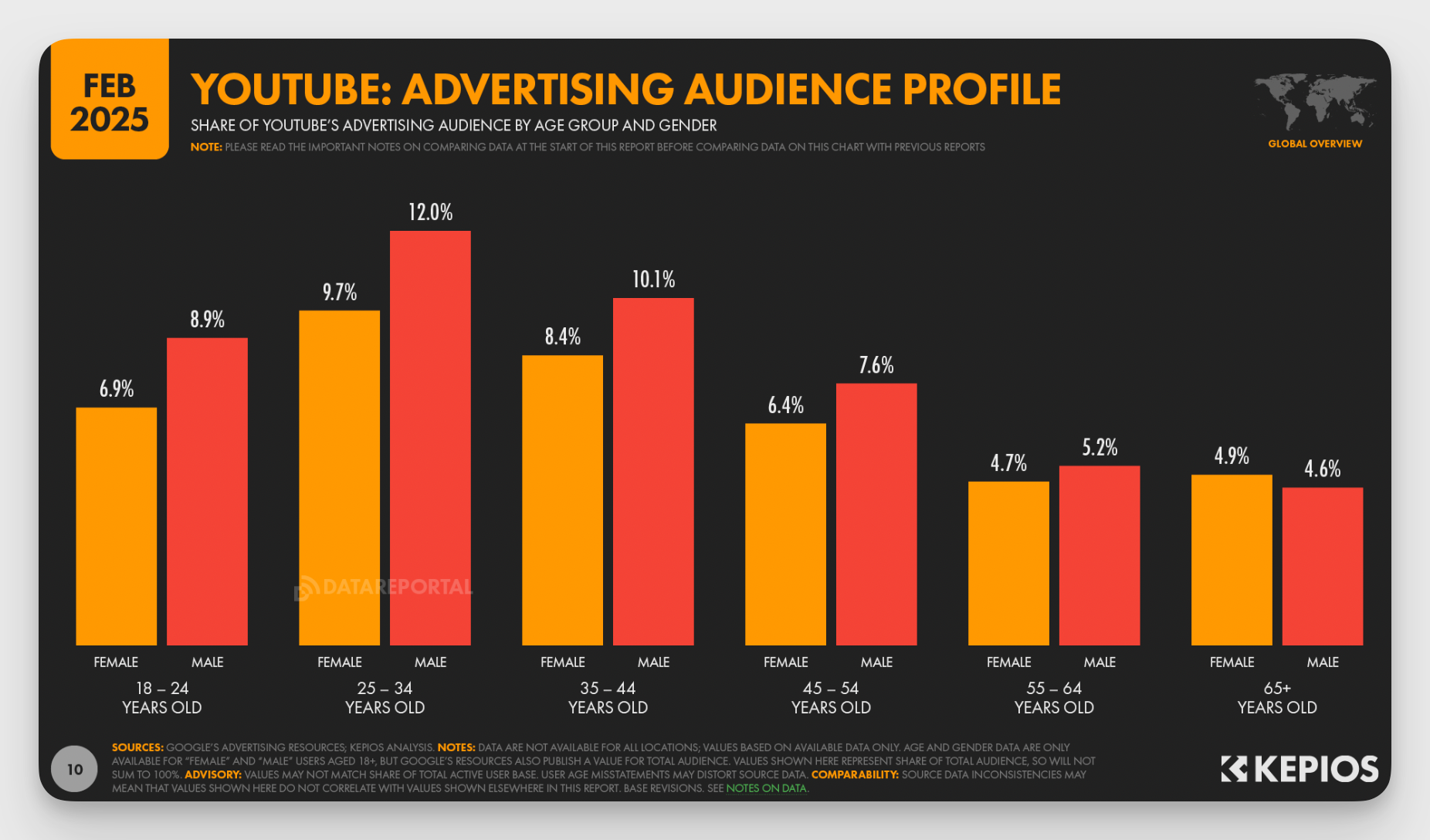
By harnessing the power of YouTube Shorts, brands and creators can effectively reach and engage the platform’s core young adult audience, aligning their content with user behaviors and preferences for fast, visually stimulating experiences that drive awareness and interaction.
TikTok vs Reels vs Shorts: 9 Differences between platforms
Given the similarities between TikTok, Instagram Reels, and YouTube Shorts in terms of the type of content published and demographics, it’s easy to put them all in the same marketing bucket.
However, TikToks, Instagram Reels and Shorts are different in many respects. The details matter, and engaged users will notice (and tax you) if you apply a one-size-fits-all strategy.
Let’s look at the subtle but important differences to help you adjust your strategy specifically for Reels or TikTok and make the best out of YouTube Shorts.
1. Platform focus
The platform focus of TikTok, Reels, and Shorts shapes user experience, content discovery, and monetization opportunities for creators.
For marketers, it influences strategic planning, content creation, and audience targeting.
- TikTok is a standalone platform dedicated exclusively to short-form content with a unique algorithm that has led to the creation of a highly engaged and creative community.
- Reels is a feature within Instagram. The difference between TikTok and Instagram Reels is that the latter is integrated into the larger Instagram environment, allowing users to create and share short videos alongside photos and other content types.
- Shorts is a feature within YouTube. Similar to Reels, YouTube Shorts is embedded within a larger platform and leverages an established user base that has access to different types of content, not just short-form videos.
TikTok’s focus on short-form videos means that the entire platform is optimized for discovering and sharing this type of content.
In contrast, the discovery mechanisms for Reels and Shorts are tied to the broader platform’s algorithms and user behavior patterns. For example, when considering TikTok vs. Reels for business, you must consider what people expect to find on each platform.
On TikTok, brands can focus entirely on creating engaging, trend-based videos. This includes participating in challenges, using popular sounds, engaging in duets, and doing stitches.
On Instagram and YouTube, brands must diversify their content strategy to maintain consistent engagement across all content types, including photos, long-form videos, live streams, etc.
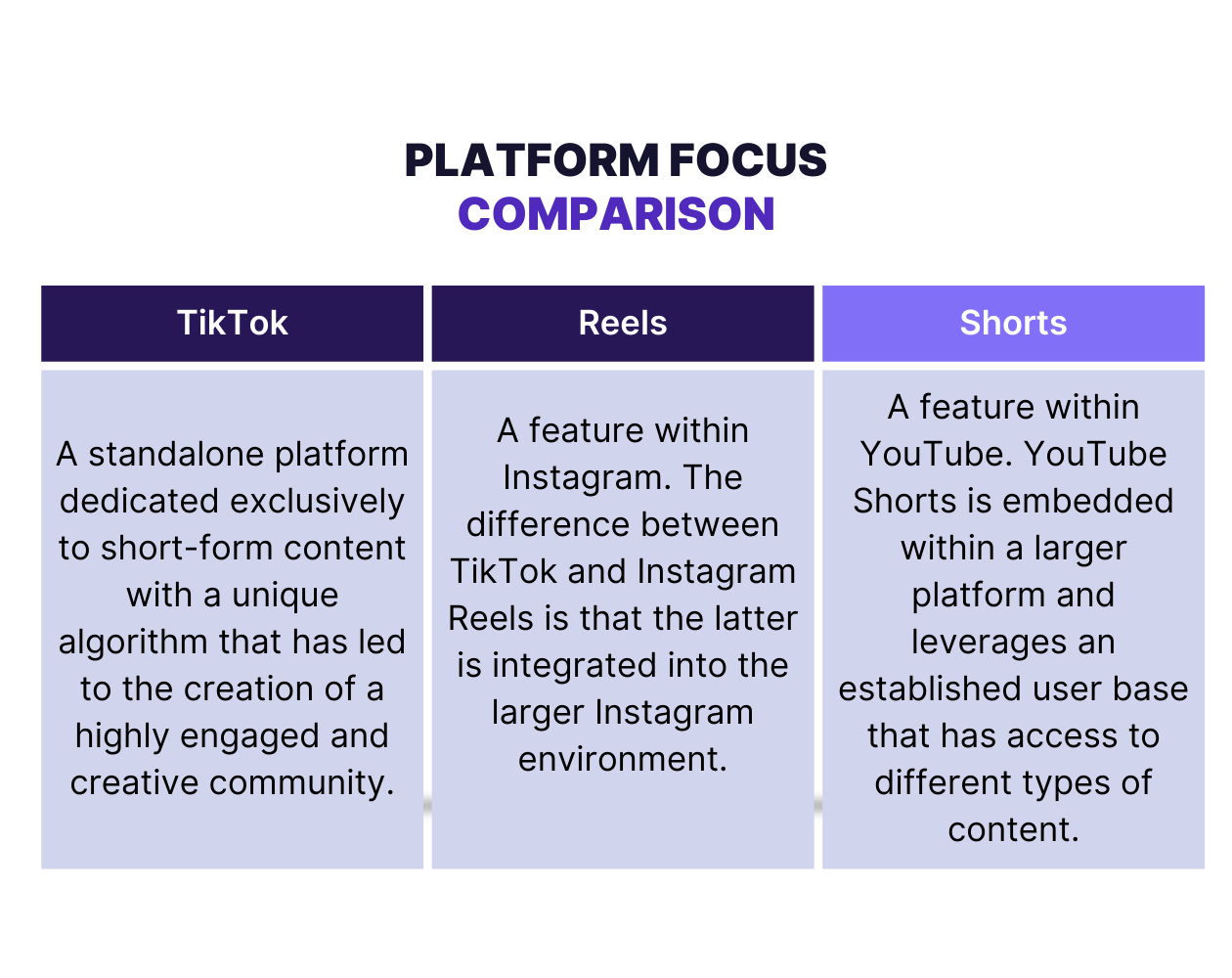
2. Video length
Video length directly influences content strategy and audience engagement.
- TikTok offers more flexibility in terms of video length. Though the platform became famous for its shorter clips, videos can now range from 15 seconds to 10 minutes. The shorter video length encourages creativity and conciseness and is more appealing to a younger audience, while the longer videos give creators a chance to explore topics more in-depth, but not to the extent that platforms like YouTube allow.
- Reels allow videos from 15 to 180 seconds. For brands with a strong presence on Instagram, Reels offer an integrated approach and the chance to complete their strategy with the popular short video format.
- Shorts also allow videos from 15 to 180 seconds. They are naturally connected to longer YouTube content, making them a strategic tool for businesses aiming to draw viewers to more in-depth videos, such as product tutorials, expert interviews, webinars, etc.
When considering whether TikTok is better than YouTube Shorts for business, the answer is: it depends on your goals.
TikTok offers an advantage for short, engaging ads, while Shorts work as teasers for educational content that can nurture leads. On the other hand, Reels is suitable for cross-promotion and more complex, integrated campaigns.
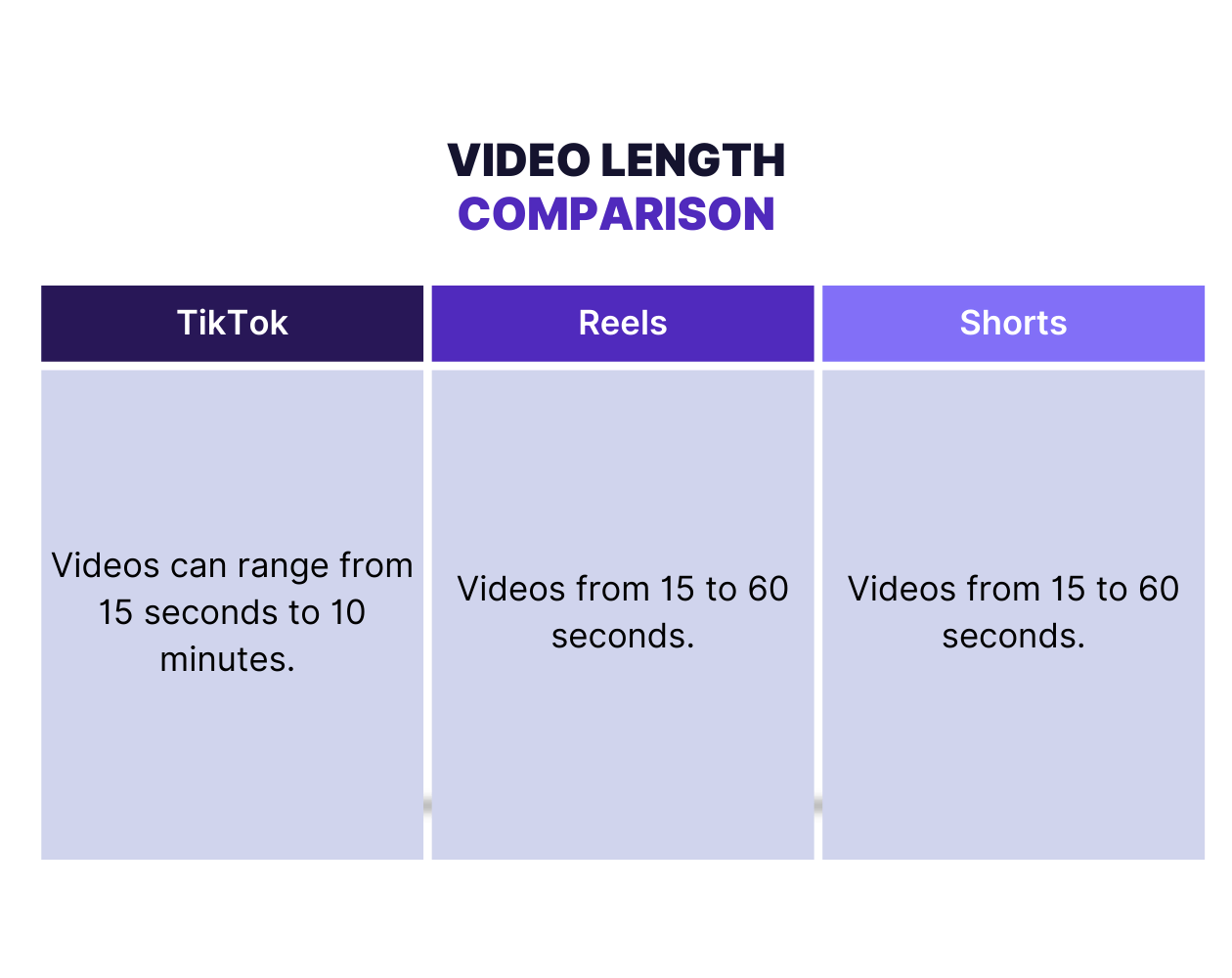
3. Content mix
The content mix on the three platforms determines how brands diversify their engagement strategies across different types of posts.
- TikTok primarily features short videos with a strong emphasis on trends, challenges, and viral content.
- Reels feature short videos that often mirror the trends on TikTok but also include content from existing Instagram influencers and brands.
- Shorts feature short videos that can drive traffic to brands’ longer content on their YouTube channels.
While TikTok's videos can be quite creative, the content tends to be repetitive, prompting brands to continually innovate within the short video format to maintain interest, increase brand awareness, and distinguish themselves from similar content.
Similarly, though YouTube shorts offer more cross-promotional value by being connected to the platform's long-form video content side, not all brands seek to create in-depth videos.
In contrast, Instagram offers a more diverse content mix, including carousels posts and single images. Brands can complement Reels with photos, Stories, and feed posts. According to our Instagram content benchmarks, brands prioritized Reels over single images, with a 12% increase in Reels volume YoY.
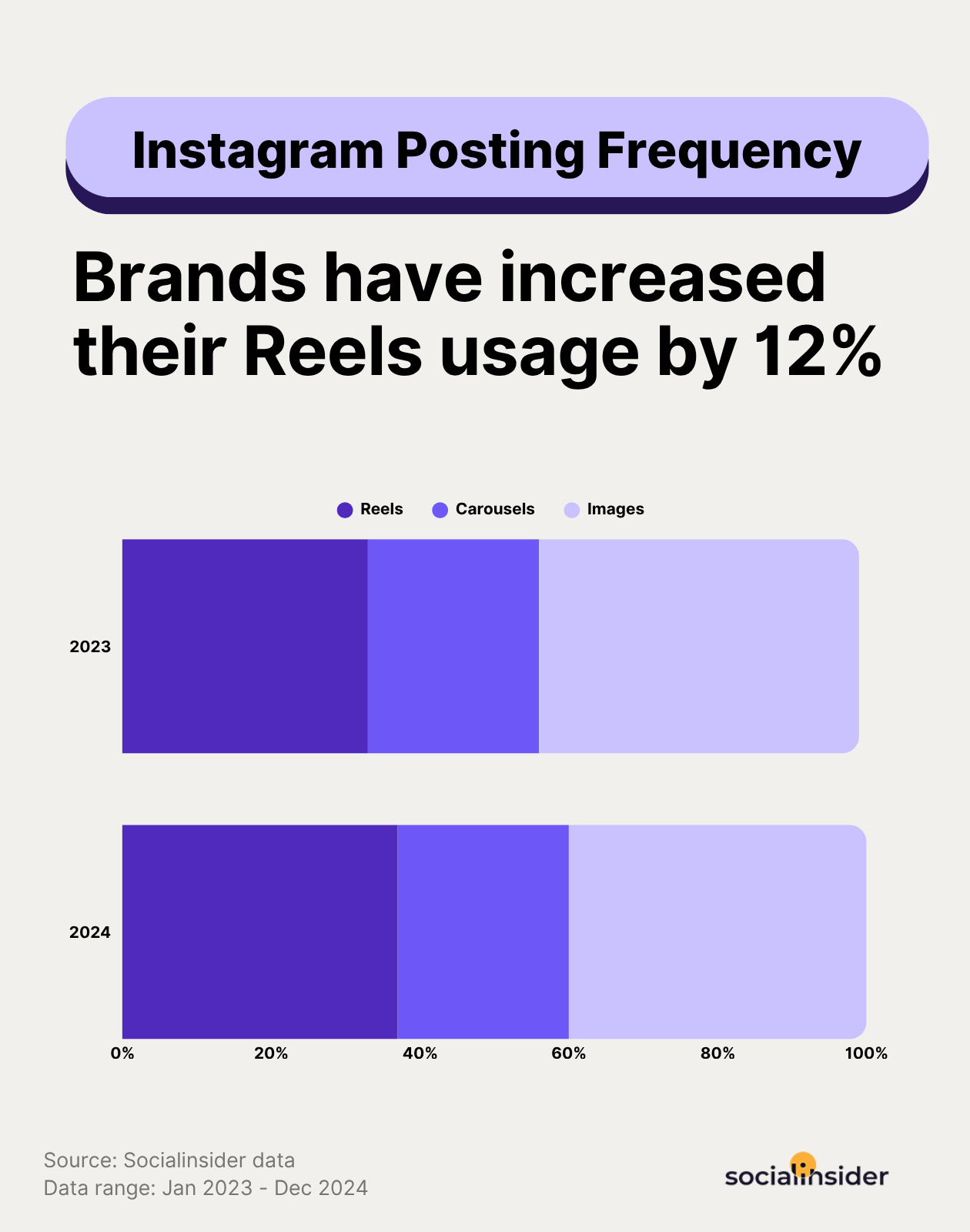
Social media managers now create a comprehensive Instagram marketing strategy to engage their audience and tell a more complete story.
For example, a retail brand can use Stories for highlighting UGC, Reels for quick, engaging store highlights, and the feed for high-quality, visually appealing product images.
When comparing Reels vs TikTok, businesses may prefer Reels if they already have an established presence on Instagram and wish to maintain a consistent brand voice across various formats.

4. Editing
Both TikTok and Instagram provide native tools for recording and editing videos, while YouTube Shorts offers more limited options. These features directly impact the quality and creativity of the published content.
- TikTok offers complex in-app editing tools, including filters, effects, text overlays, and sound synchronization.
- Reels provide various editing tools, such as AR effects, timers, and alignment tools, though they are somewhat less extensive than TikTok.
- Shorts include basic editing tools, such as multi-segment camera options, speed controls, and a timer, but are less comprehensive than TikTok.
Of the three, TikTok is the clear winner when it comes to in-app editing features. The tools enable users to produce highly engaging content quickly without needing external editing software.
While this is appealing for independent creators, brands typically have access to more advanced resources and expertise and will most likely produce and refine videos in third-party tools before uploading them.
If you’re growing a small brand and looking to streamline creation while cutting costs, you'll enjoy TikTok’s more complex editing features.
Many creators also download the TikTok video and reuse it on other platforms, though, in this case, it’s advisable to do further editing to remove the TikTok watermark for a professional look.
When reusing videos, you’ll also want to consider differences in target audiences and whether the same engaging mechanisms work on TikTok vs. Reels vs. Shorts.
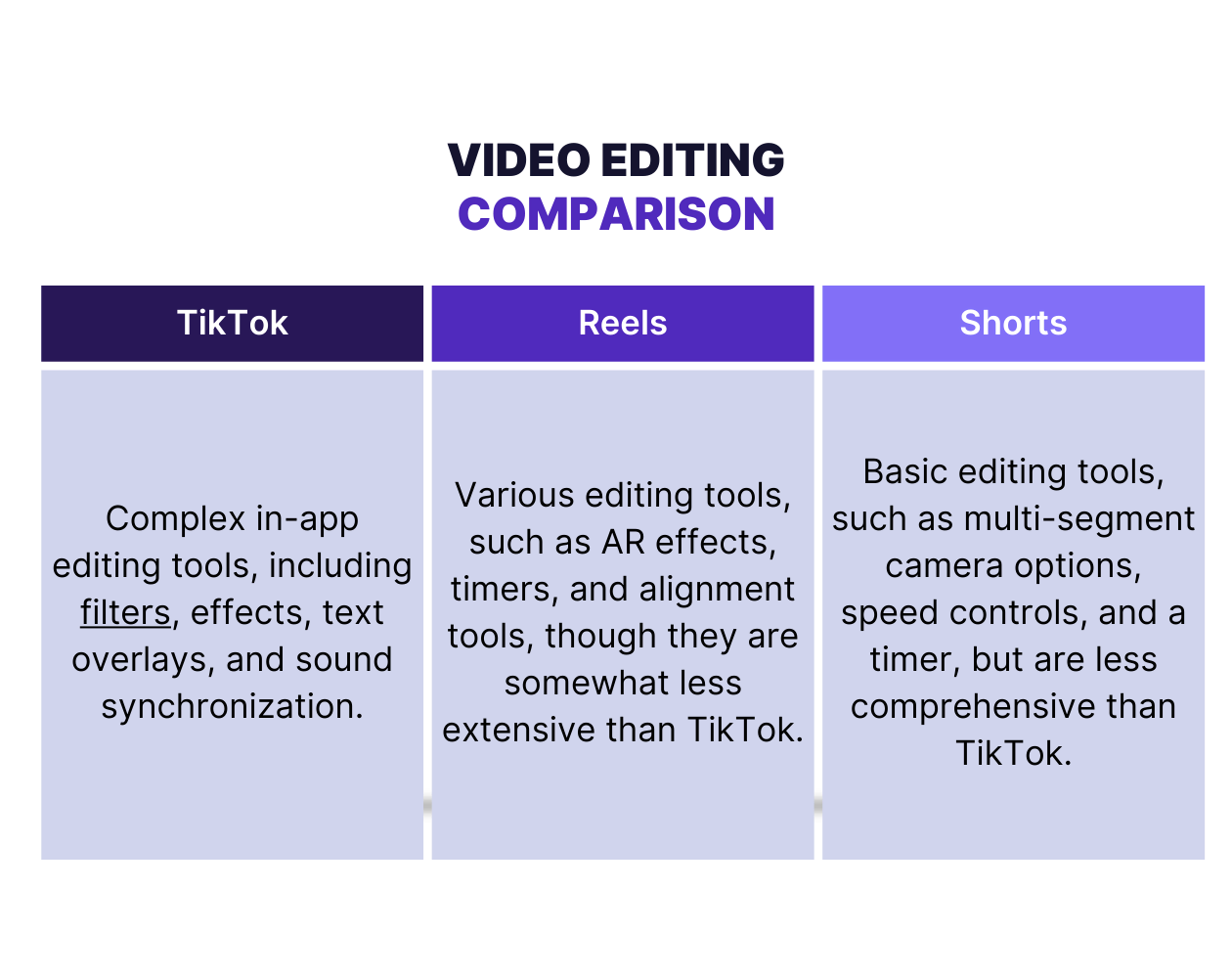
5. Target audience
Imagine trying to have a conversation, but everyone speaks a different language. That’s what happens when businesses use the same message on TikTok, Reels, and YouTube Shorts.
Each platform has a specific audience with different expectations, behaviors, and jargon.
- TikTok is like the hangout for Gen Z, all about quick, creative clips (many even poking fun at older generations), though it has started to attract more diverse age groups.
- Reels appeal to Instagram’s broader user base, including both younger and older demographics who enjoy a mix of fun and familiarity.
- Shorts target YouTube’s diverse audience, spanning all age groups and interests. Given YouTube’s massive popularity, the audience is a mashup of all ages and interests.
So, how do you choose between the three? First, define your target audience and see how it matches that of the platforms. Second, understand how engaging with each demographic can help you achieve your social media marketing goals.
TikTok has a more experimental vibe, and its high engagement rates make it perfect for brands looking to innovate and connect with a tech-savvy, dynamic demographic. This audience is more likely to adopt new products and give niche offerings a chance, but also more exigent with anything commercial-related.
In contrast, the diverse demographic mix of Instagram gives social media managers the chance to develop a more varied content strategy to reach different audience segments.
Is Instagram Reels better than TikTok in this respect? The broader demographic of Reels is certainly appealing, particularly for brands that already have an established Instagram following. The same is true for YouTube Shorts, where a brand can access a huge, diverse user base.
However, there are other factors to consider. As we’ll explain in more detail below, data shows that, while catering to a narrower audience, TikTok has double the engagement rate, which is mostly due to its algorithm.
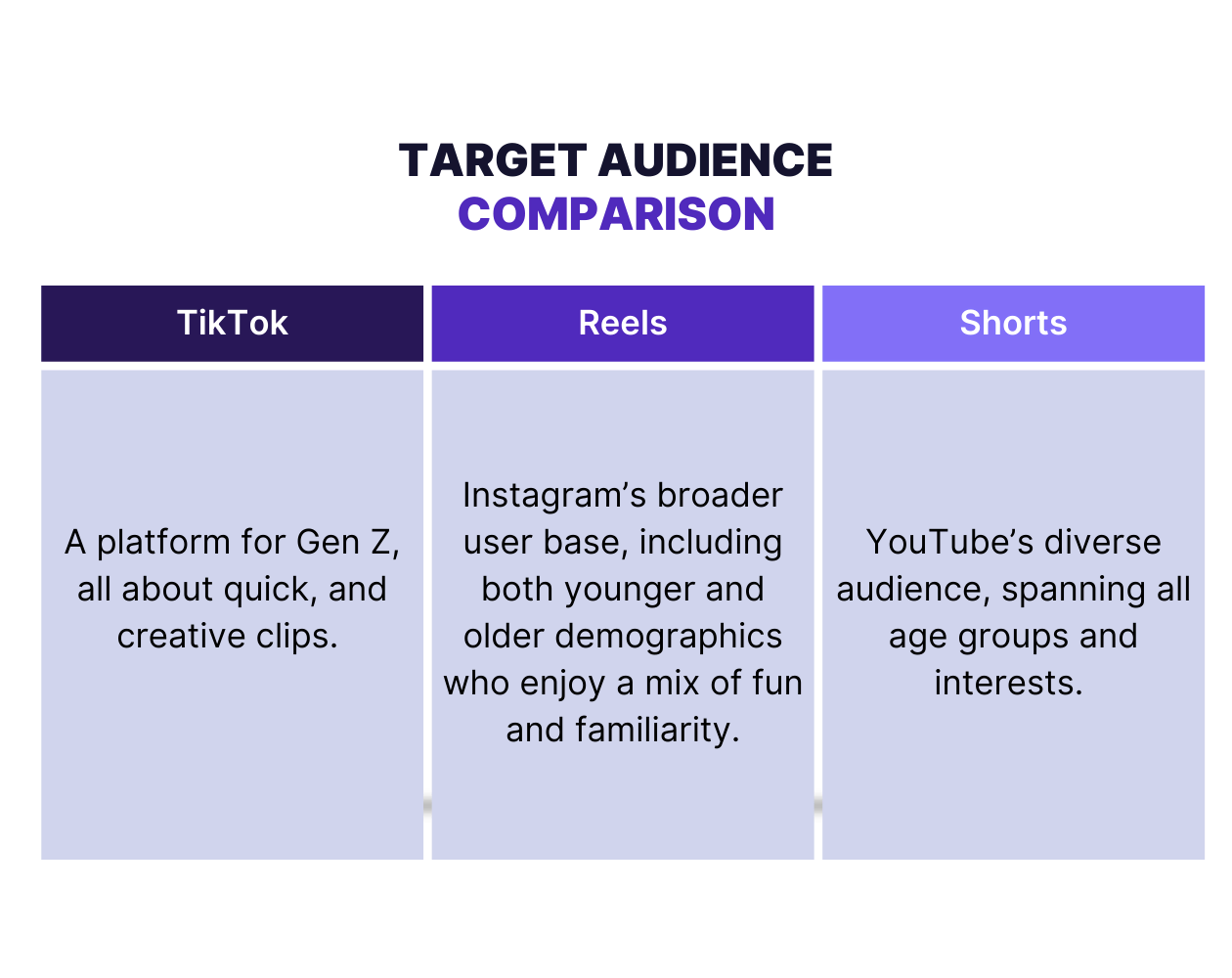
6. Algorithm
Each platform has a secret sauce: an algorithm that decides what content users see.
- TikTok stands out through its highly personalized “For You” page, which uses a sophisticated algorithm to serve content based on user behavior and preferences.
- Reels content is shown in the main Instagram feed, Stories, and the Explore tab, leveraging Instagram’s existing algorithm.
- Shorts are primarily featured on the Shorts shelf on the YouTube homepage, where they benefit from YouTube’s recommendation system, which promotes popular and relevant content.
TikTok’s algorithm is designed as a “mind reader,” serving personalized videos that keep users hooked. It is also known for favoring unknown, new users who sometimes go viral overnight. This means that even a new business can become popular quickly by striking the right chord with the scrolling crowds.
Compared to Reels and YouTube Shorts, TikTok definitely has the algorithmic upper hand, and its engagement rates make it tempting for any brand or creator. However, as every marketing manager knows, content strategies must take into account a variety of factors, especially when it comes to spending big bucks.
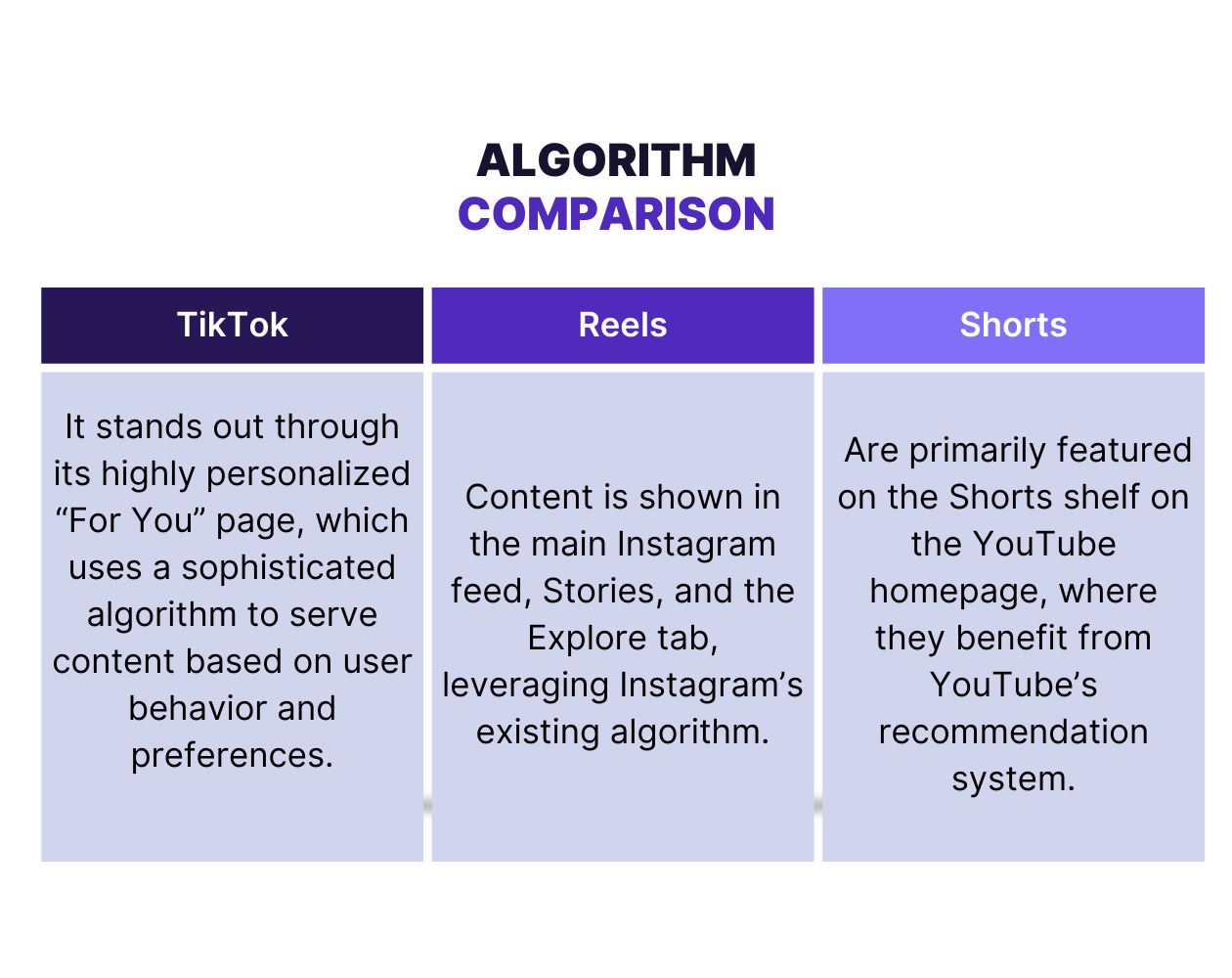
7. Advertising
Where are your advertising dollars best spent? Each platform offers distinct advantages.
- TikTok stands out with ads that feel like part of the party, not party crashers: in-feed ads that look like regular videos, branded hashtag challenges, and special effects users can play with.
- Reels provide advertising opportunities through Instagram’s ad platform, including sponsored posts, Story ads, and in-Reels ads. The platform is designed to expand your interactions, so it is a great option if you want to create an ad campaign that flows seamlessly across different sections and leverages various content formats.
- Shorts integrate with YouTube’s ad platform, offering pre-roll ads and other monetization options for creators. YouTube’s extensive search and discovery features can boost ads to a diverse and engaged audience.
You can strategically use all three platforms to achieve goals such as enhanced brand awareness, improved conversion rate, lead generation, and better social media ROI.
Be clear about your objectives, set up your campaign target audience in detail, match content to users’ expectations on each platform, and keep an eye on social media campaign analytics. These will help you understand performance and refine your ads.
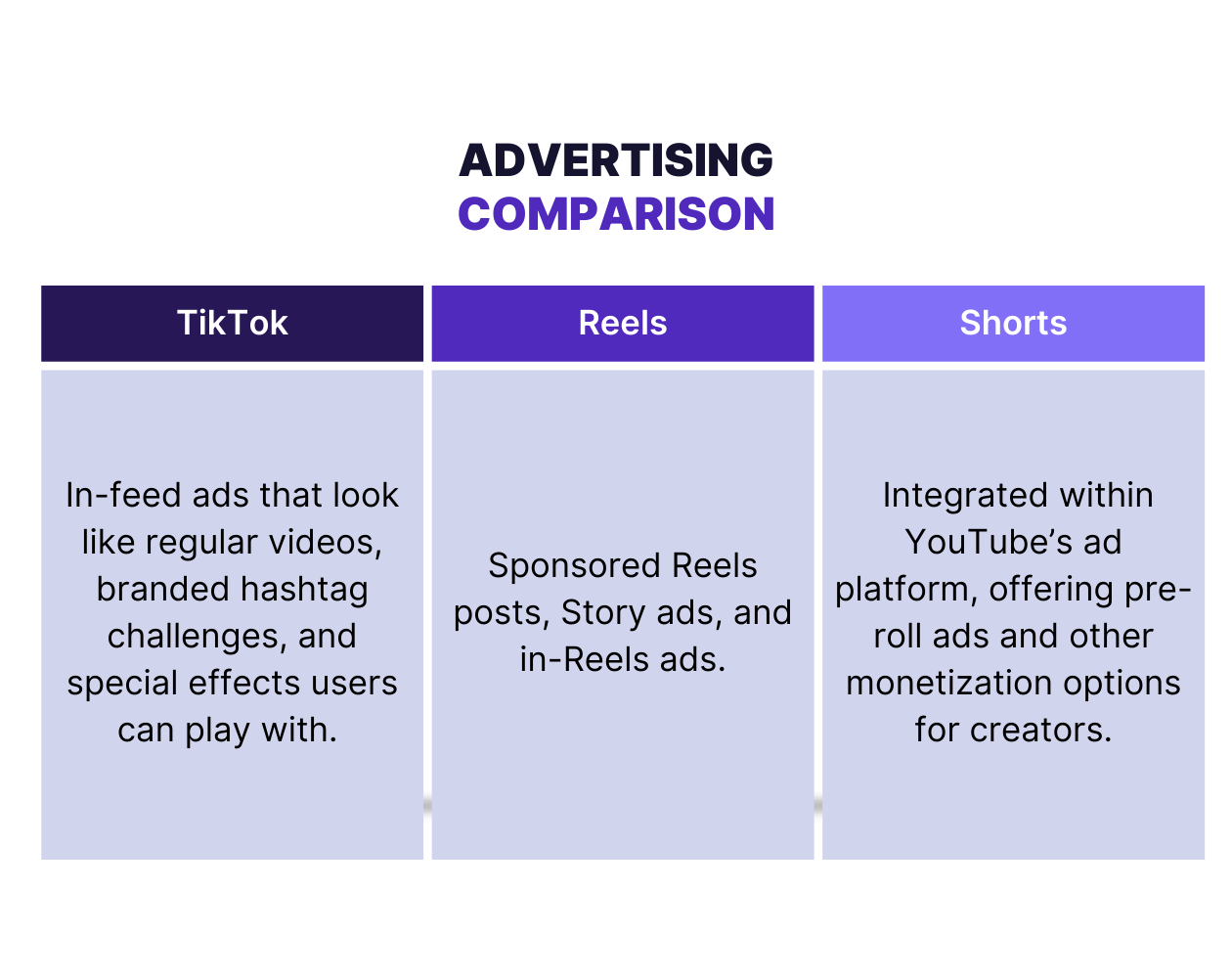
8. Music
A certain sound or melody can make or break the success of your short-form content. Here’s an overview of TikTok, Reels, and Shorts music accessibility.
- TikTok provides an extensive library of music and sound effects, allowing users to create synchronized and trendy videos.
- Reels leverages access to Instagram’s music library, which is broad but sometimes less varied than TikTok’s offerings.
- Shorts gives users access to YouTube’s extensive music library, allowing creators to choose from various tracks.
In terms of audio options, TikTok definitely wins over Instagram and Shorts. TikTok has transformed how music is integrated into social media, making it very easy for users to incorporate sounds into their clips. Additionally, sounds play a central role in content discoverability, and music (even older ones) often achieves commercial success after going viral on TikTok.
When comparing YouTube Shorts vs. TikTok vs. Instagram Reels for music integration, businesses must consider the specific needs of their campaign and how effectively each platform’s music features align with their content strategy.
A dynamic B2C brand that wants to make a splash on TikTok and attract young audiences must absolutely learn how to leverage musical trends in content. A B2B business looking to drive traffic to long-form education content will do just fine with the Shorts music integration.
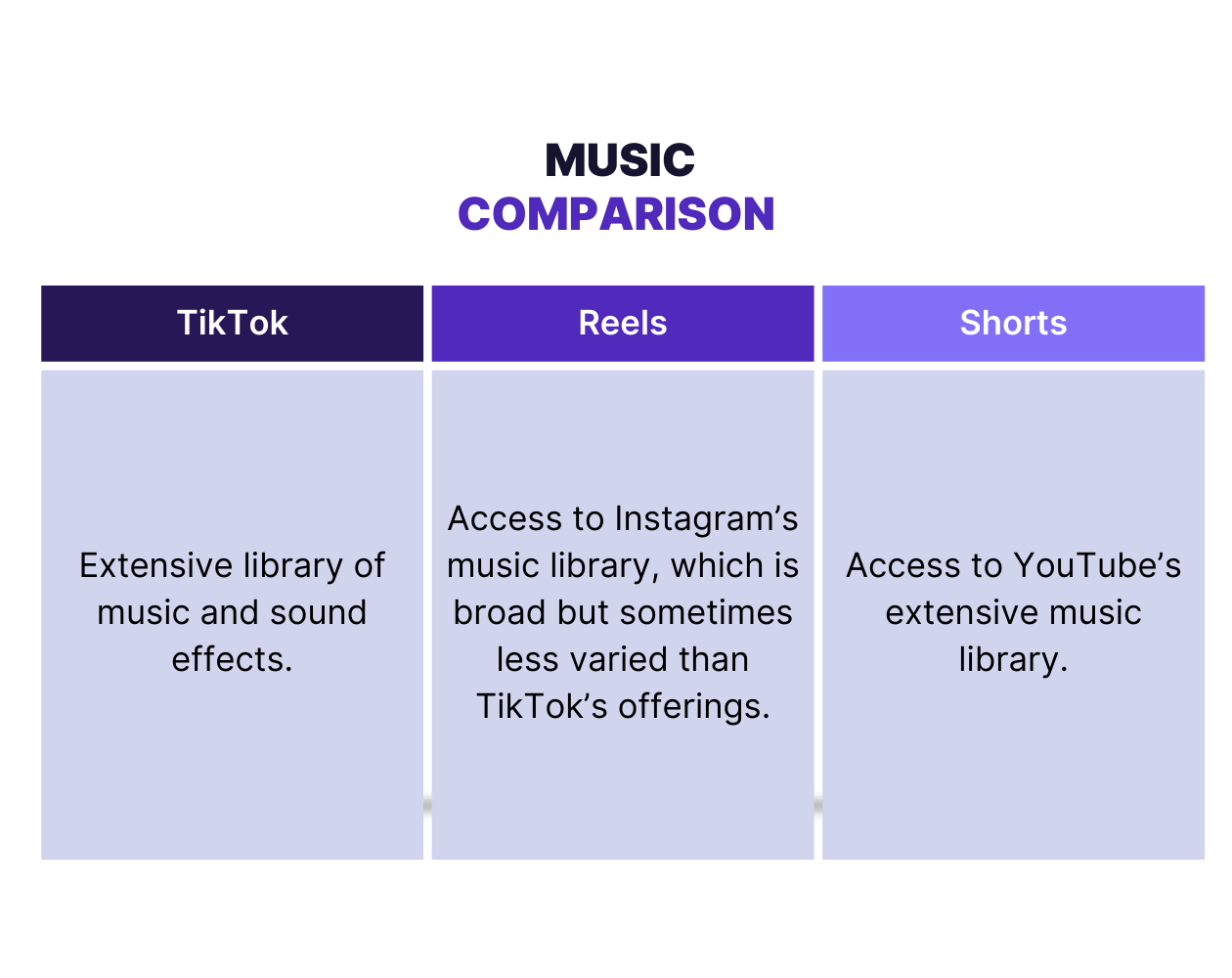
9. Analytics
Platform analytics help businesses understand content performance and audience engagement across TikTok, Reels, and YouTube Shorts. Each social networks analytics offer unique insights that help marketing managers optimize content strategy and marketing efforts.
- TikTok provides analytics through its Business Account. Metrics: video views, follower growth, profile views, engagement statistics. You can also measure your TikTok performance using a more comprehensive analytics tool.
- Reels offer analytics through Instagram Insights, including demographic data and integrated analysis with other Instagram content. Metrics: reach, impressions, likes, comments, shares, saves.
- Shorts use YouTube’s analytics tools to provide comprehensive data that allows the analysis of both short-form and long-form content performance. Metrics: views, watch time, audience retention, demographics.
Tracking analytics across multiple platforms can quickly become confusing and time-consuming for marketing managers. Each platform has its own set of metrics and dashboards, which can lead to fragmented data and difficulty in gaining a comprehensive view of performance.
As an alternative, businesses can use a social media analytics tool like Socialinsider that centralizes data from various platforms into a single interface, providing a cohesive social media dashboard. This enables brands to see the big picture and make strategic decisions about optimizing short-form content, not just do isolated fixes.
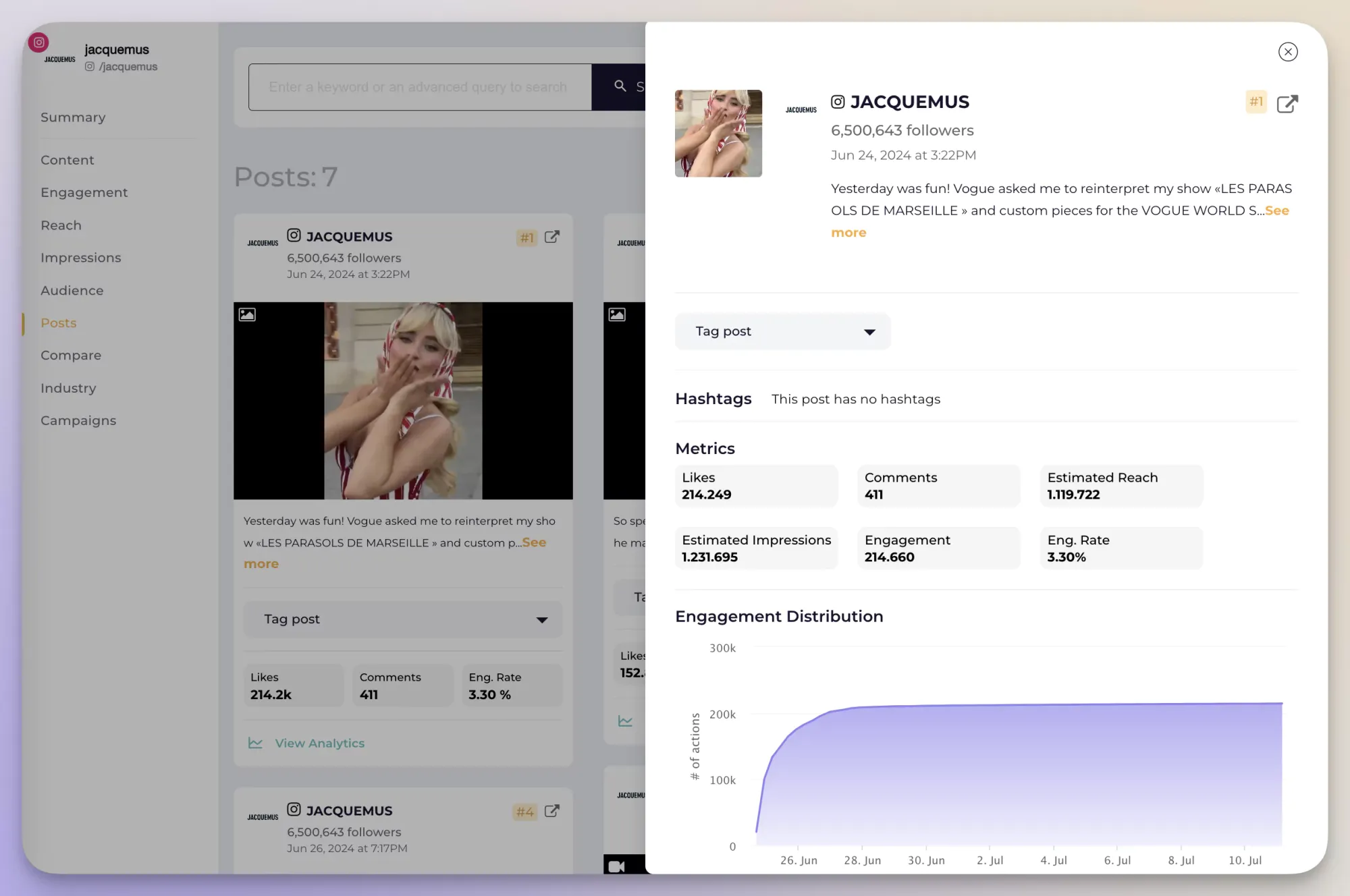
Talking about strategic decisions, let’s look into the latest data behind TikTok, Reels, and Shorts to help you take data-driven actions on these platforms.
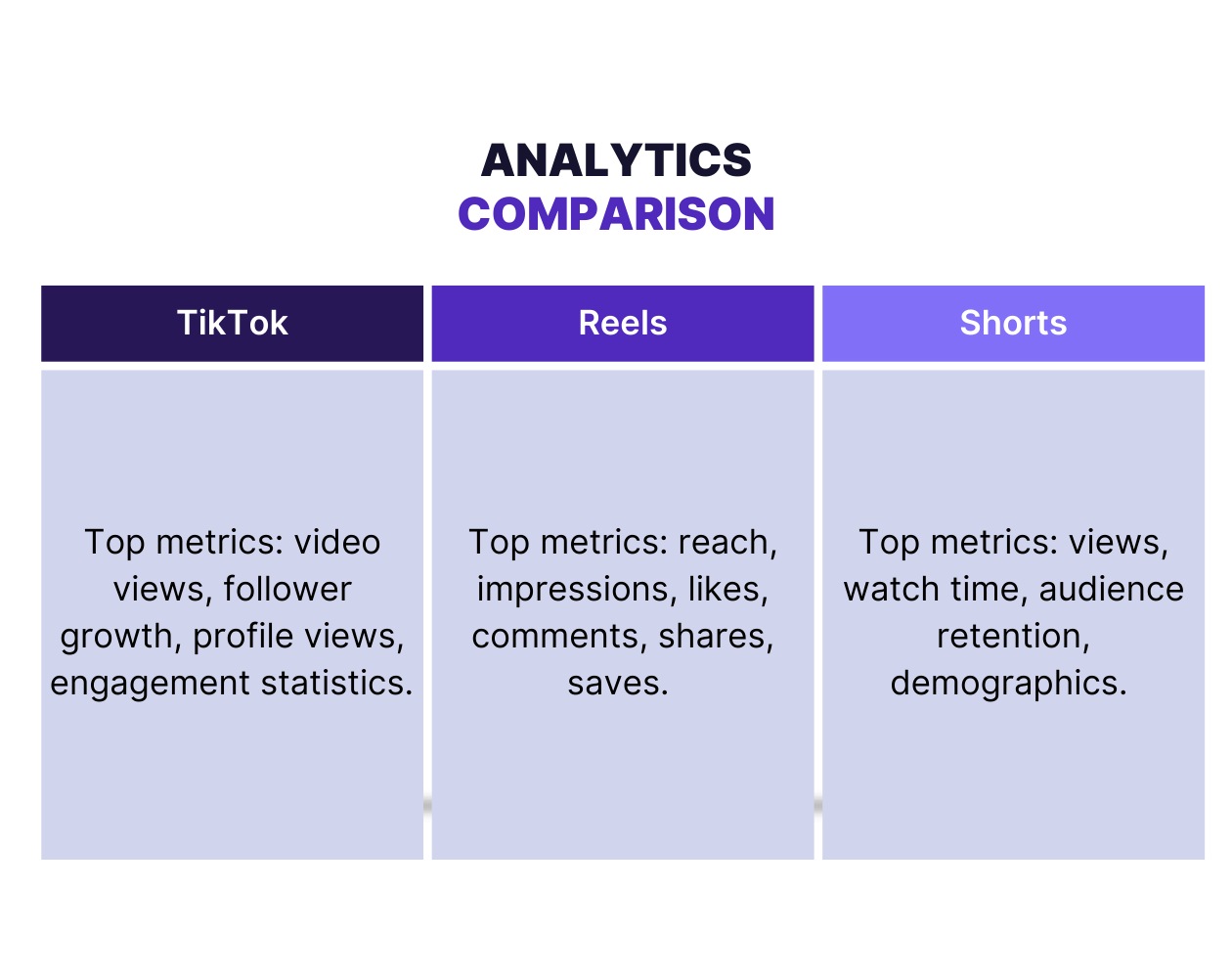
TikTok vs. Reels vs. Shorts: Key statistics
While platform algorithms are elusive — always changing and not letting people in on their secrets — data doesn’t lie.
We measured engagement rates, watch times, and other key metrics across TikTok, Reels, and Shorts, and here’s a breakdown of the findings:
- TikTok is the most engaging short-form video platform: TikTok takes the gold medal with a whopping 2.34% engagement rate, meaning viewers are more likely to like, comment, or share your content. Reels comes in second at 1.48%, while YouTube Shorts trails behind at 0.91%.
- TikTok sparks 3x more conversations than Reels: When it comes to sparking conversation and community building, TikTok shines (again) with the most comments compared to Reels and Shorts.
- TikTok scores the highest watch rate — with drops across the board for big accounts: Interestingly, while Reels had the highest average watch time in 2023, TikTok captured the top spot for this metric, too, in 2024. It’ll be interesting to see if this trend continues.
While TikTok takes the crown on multiple statistics, don’t hurry to log out of the other two.
Keep reading for an in-depth TikTok vs. Instagram Reels vs. Shorts data analysis and expert recommendations.
TikTok is the most engaging short-form video platform
When weighing the potential of short-form video platforms, I always pay close attention to engagement rates—they’re the most telling metric of how audiences are actually interacting with content. After looking closely at the data for 2024 and projections for 2025, the differences between TikTok, Instagram Reels, and YouTube Shorts are clear.
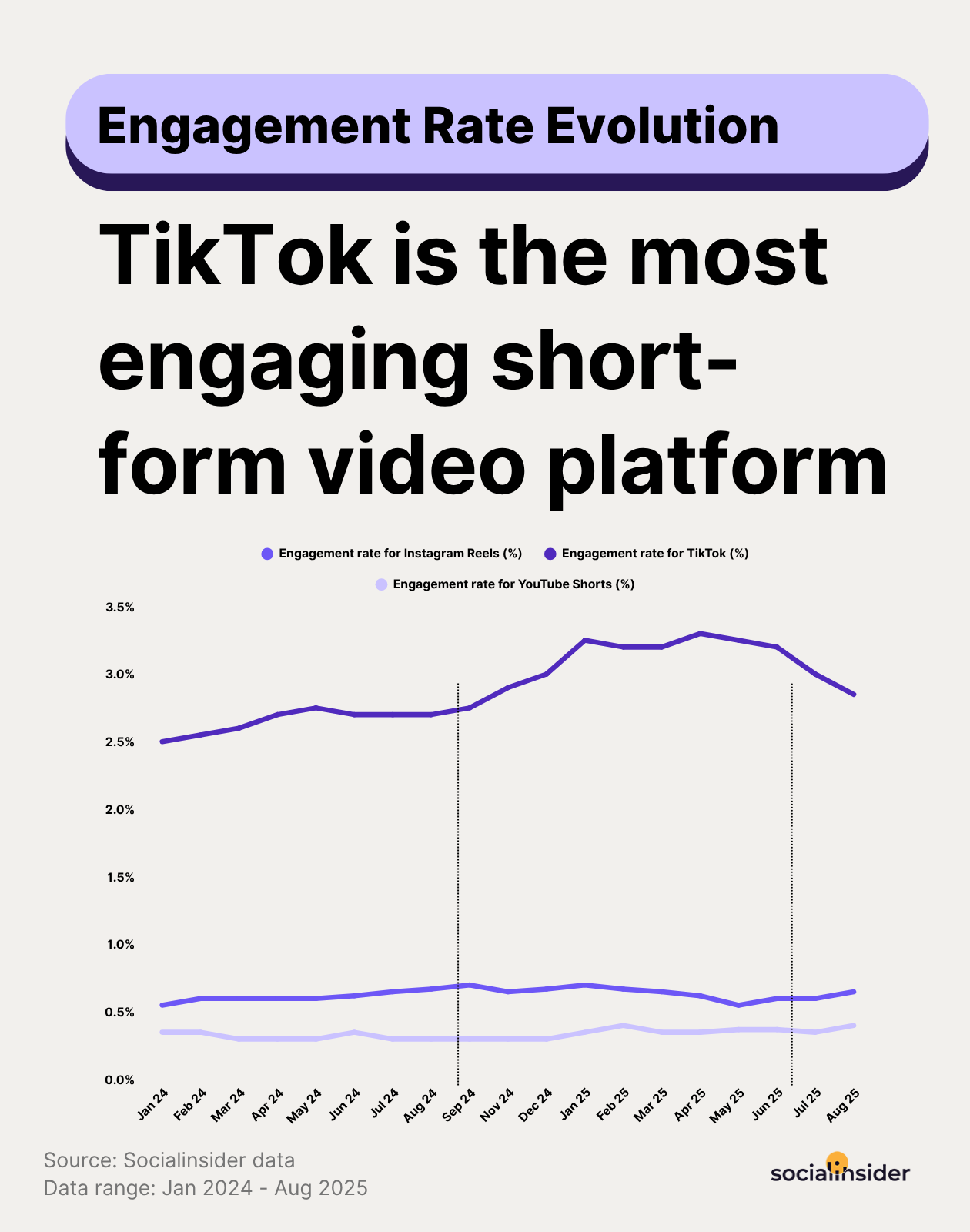
For 2024, TikTok stands out with an average engagement rate of 2.80%. That figure alone speaks volumes about how active and involved its user community is. In contrast, Instagram Reels comes in noticeably lower at 0.65%, and YouTube Shorts trails further behind at 0.30%.
Looking ahead to 2025, the gap remains significant. TikTok is projected to push its engagement rate up to 3.15%, while Instagram Reels is expected to hold steady at 0.65%. YouTube Shorts shows some upward momentum, with a projected rate of 0.40%.
Here’s the comparison at a glance:
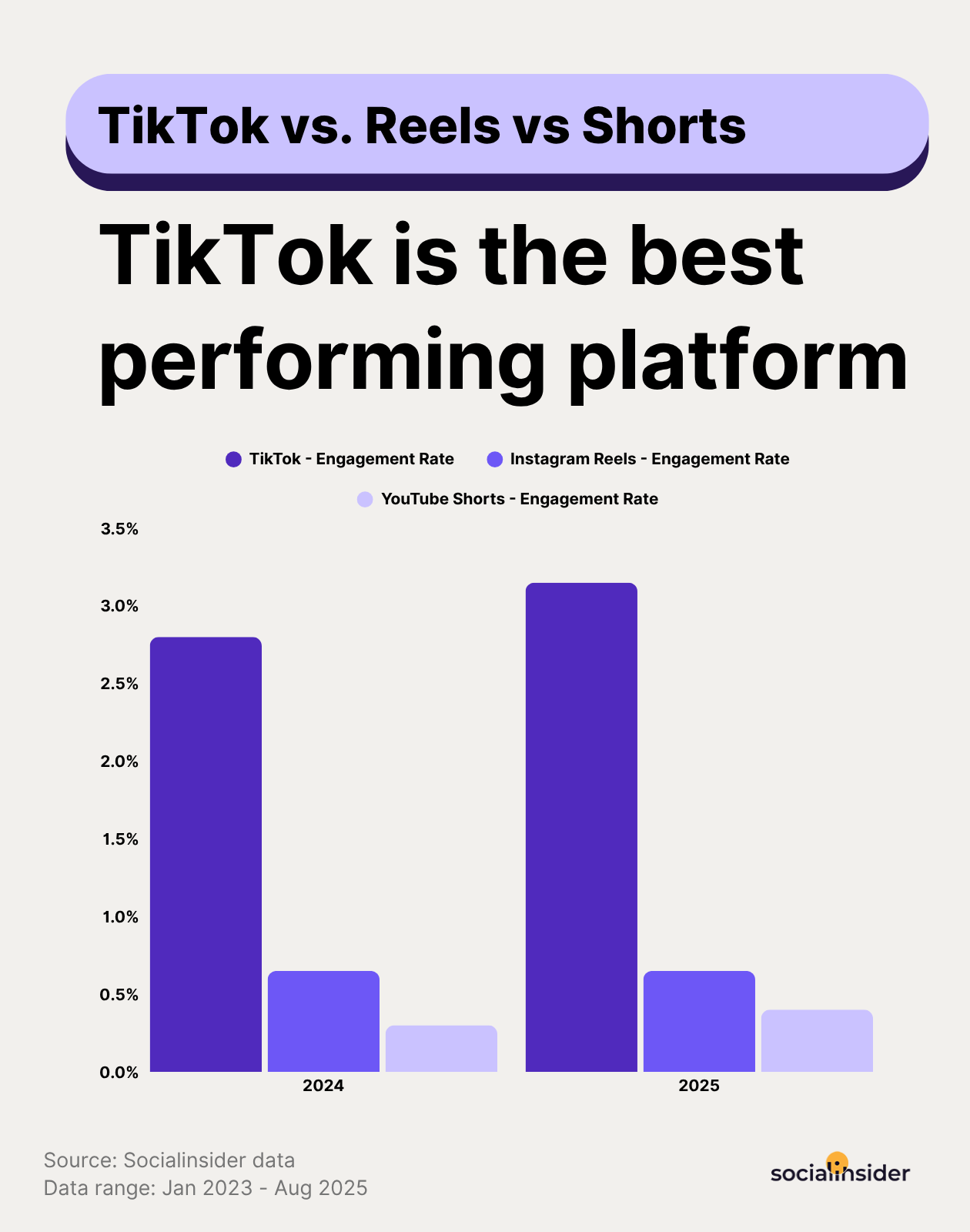
For me, these numbers reinforce what my experience has already suggested: If my priority is driving tangible engagement—especially likes, comments, and shares—TikTok clearly offers the most dynamic environment right now. Instagram Reels remains a reliable option, particularly for reaching audiences already active on Instagram, and YouTube Shorts, though still emerging, is making incremental gains.
TikTok sparks 2x more conversations than Reels
When I think about genuine interaction on short-form video platforms, comments are always a big indicator of how active and engaged a community really is. They’re where the real conversations happen—feedback, jokes, debates, and that sense of back-and-forth you just can’t get from simple views or likes.
Looking at the average number of comments per video, there’s a pretty clear hierarchy. TikTok sits at the top, with an average of 54 comments per video.
Instagram Reels comes in next, averaging 35 comments per video. While it doesn’t quite have the same volume of discussion as TikTok, there’s still a healthy level of back-and-forth—especially when content hits the Explore page or taps into the right hashtags. Reels has built a solid community spirit, just maybe with a bit less noise than TikTok.
YouTube Shorts rounds out the list with about 20 comments per video. Shorts is still growing as a home for quick interactions, and it tends to attract briefer responses. While the comment sections aren’t quite as lively, there’s potential for those looking to start genuine dialogues as the format evolves.

For me, if sparking conversation is the goal, TikTok is the standout choice right now. That said, both Reels and Shorts still offer space for brands and creators to build community through comments—just on a slightly quieter scale. As these platforms keep evolving, I’m keeping an eye on how these conversations grow and where audiences are the most talkative.
Instagram Reels get the least views
When I look at average video views across follower brackets, one trend stands out: YouTube Shorts consistently delivers surprisingly strong reach for small and mid-sized accounts—often outpacing both TikTok and Instagram Reels in those early growth stages.
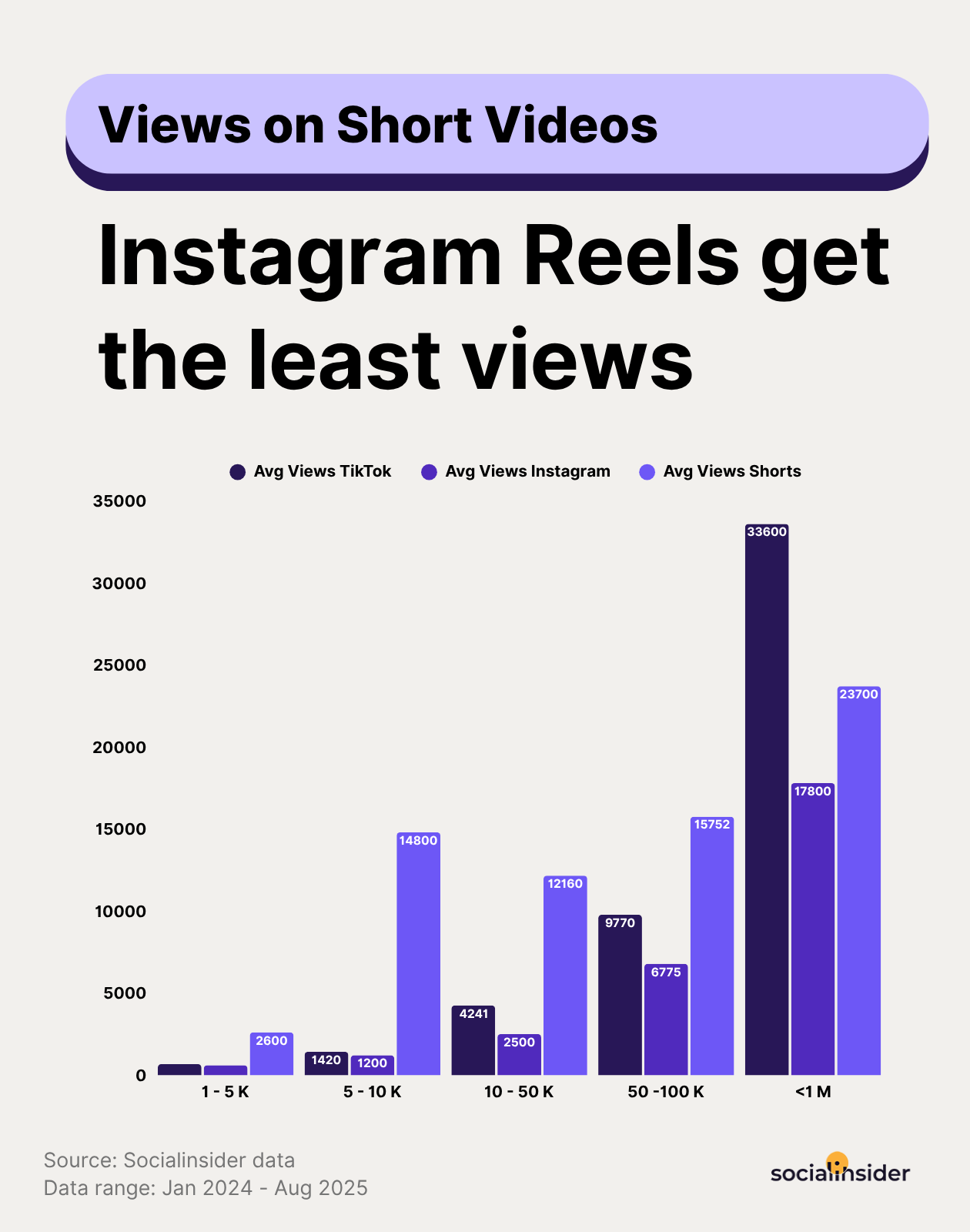
I find it remarkable just how much traction creators can get on Shorts even without a massive following. As the audience size grows, TikTok steadily closes the gap and then takes the lead, delivering the highest average views for creators approaching the million-follower mark. Instagram Reels remains a steady player throughout, but doesn’t quite hit the heights of the other two.
Reels vs. TikTok vs. Shorts: Choosing the right platform for your brand
So, after all the data and analyses, which is the best short-form video platform in 2025? Here’s our verdict:
Engagement champion: TikTok
Looking to boost brand awareness and spark engagement?
TikTok is better than Reels and Shorts, according to the data.
Its vibrant community thrives on trends, challenges, entertaining snippets, music videos, and more. This makes it ideal for capturing youthful demographics and nurturing a highly interactive brand connection.
Strategic community building: Instagram Reels
For established brands, Instagram Reels offer a strategic space. Leverage this platform for educational content, such as product demos or behind-the-scenes glimpses.
Reels seamlessly integrate with Instagram’s existing audience, making them ideal for deepening brand loyalty and showcasing your expertise and products in a more interactive way.
However, keep innovating and don't get too comfortable, or you might get lost in the Instacrowd.
The power of discovery: YouTube Shorts
Shorts excel as a discovery tool, particularly for brands and creators already established on YouTube. Use this platform to create captivating short-form content that entices viewers to explore your longer-form videos.
YouTube’s powerful search and recommendation features are a marketer’s dream, but success isn’t guaranteed. For a solid marketing approach, explore other platforms alongside YouTube.
TikTok, Reels, and Shorts best practices
Here are a few best practices to keep in mind in your long-term short-video journey:
- Know your audience and tailor content to match their interests and each platform’s particularities.
- Grab attention in the first few seconds of the videos with a compelling intro.
- Create videos around 60 seconds to maximize engagement.
- Optimize content for soundless viewing, too. Use captions and visuals to make your content compelling, even on mute.
- Tap into trending topics and hashtags for discoverability.
- Analyze social media performance and refine your strategy continuously.
- See what's working for similar brands and popular creators through competitor analysis and adapt their winning elements for your own content.
Final thoughts
Short-form video is a marketing essential, not just a trend.
With TikTok, Reels, and Shorts all offering unique advantages, a multi-platform approach is often your best bet. Start with the platform that best aligns with your target audience and brand goals, then expand using data to guide you.
Socialinsider provides analytics across TikTok, Reels, and YouTube, helping track performance and optimize strategies. Experiment with different formats, hashtags, and styles to see what resonates most.
Creativity is key, so have fun and let analytics tools handle the heavy lifting.
Methodology
The findings of this study are based on the analysis of Shorts, Reels, and TikTok videos posted between January 2024 - August 2025.
TikTok’s engagement rate per post (by followers) is calculated as the sum of likes, comments, and shares on the post divided by the total number of followers that page has. The result is then multiplied by 100.
Instagram’s Reels engagement rate per post (by followers) is calculated as the sum of Reels' likes and comments divided by the total number of followers that the profile has. The result is then multiplied by 100.
YouTube Shorts’ engagement rate per post (by followers) is calculated as the sum of posts' likes and comments divided by the total number of followers that profile has. The result is then multiplied by 100.
Analyze your competitors in seconds
Track & analyze your competitors and get top social media metrics and more!
You might also like
Improve your social media strategy with Socialinsider!
Use in-depth data to measure your social accounts’ performance, analyze competitors, and gain insights to improve your strategy.

